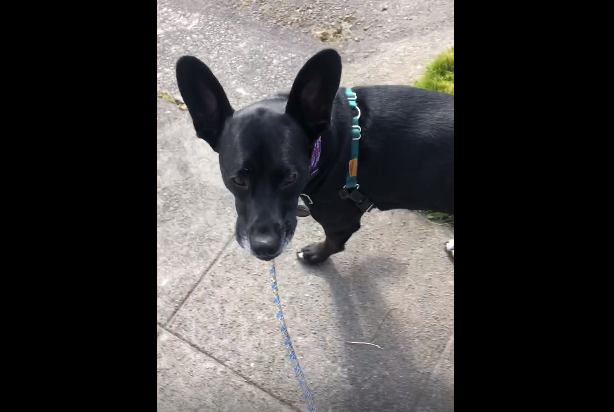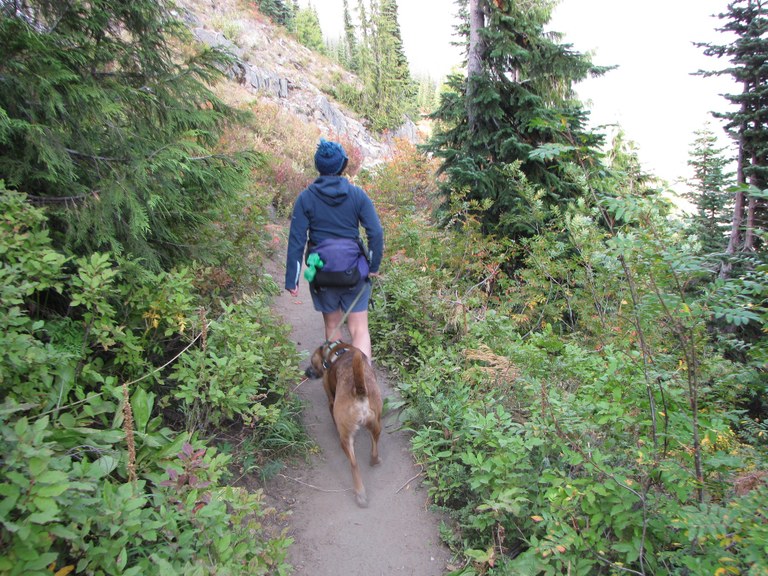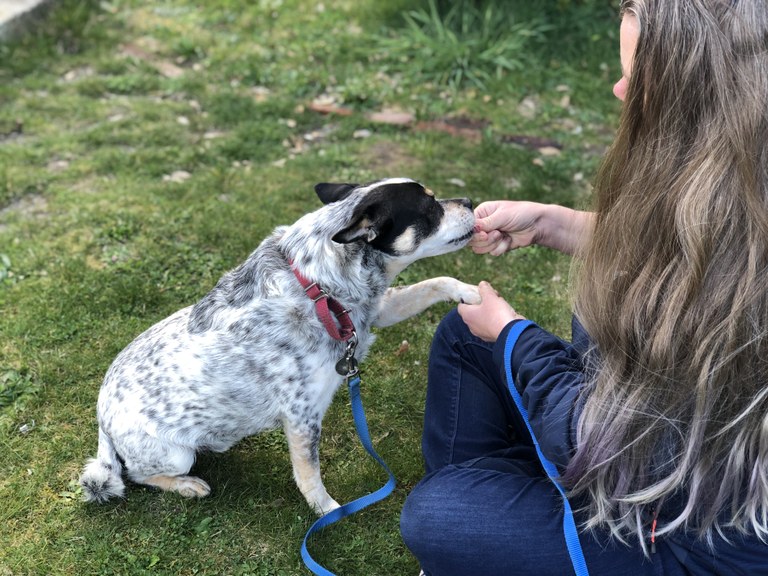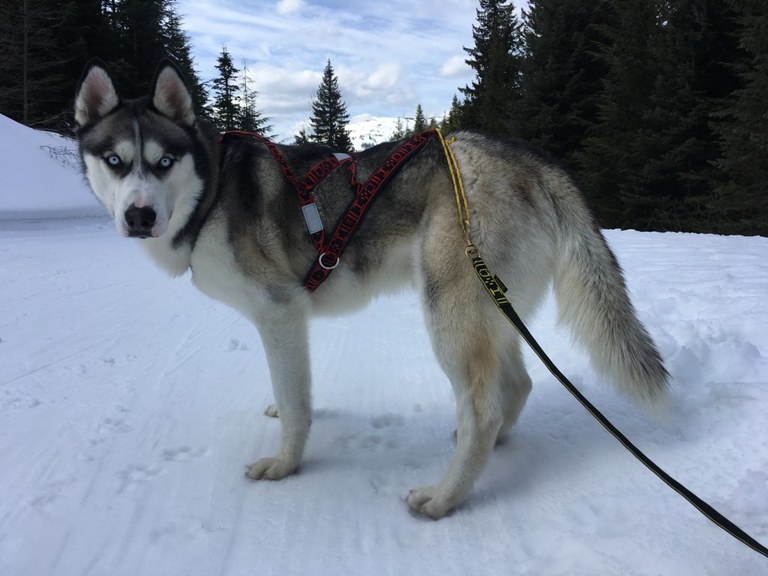3 Trail-Worthy Skills to Teach Your Hiking Pup at Home
Here are three essential skills that all good hiking dogs need to know when you hit the trails. They are surprisingly easy to work on in your living room or on strolls around the blog.
No matter how old your puppy is, they never stop learning. So, if you and your doggo are spending more, er, quality time together right now, here is how you can work on their trail skills from your apartment or house.
We're not dog trainers, but a lot of us here at WTA hike with dogs, and these are some of the areas we have found the most useful.

Practicing touch with hiking-dog-in-training Lula in our living room. Photo by Tyler LePard.
1. Focus work
Getting your dog to focus on you when they are surrounded by trail sights and sounds can be a challenge. But it is well worth the work, when they pay attention to you rather than that super exciting squirrel darting in front of you on a steep, precarious section of trail. It can also come in handy to work on a stronger heel.
You can train a variety of commands in the focus category; think of each one as an extra tool in your toolbox.
- Touch: The most basic focus work, and one very young puppies can pick up. With this skill, you are asking your dog to touch their nose to your fingers (and, of course, get a reward for doing so). This is a fun one that can help you will a stronger heel and can be used to help build up recall. Start up close, and work your way across the room.
- Look at me: One you can build on, from getting your dog to recognize their name to more advanced versions, where they are capable of looking at you when a skateboarder is flying by singing jingle bells.
- Look at that: This is a skill that can be employed to help your dog get used to unusual sights, like other dogs, livestock, kids or hikers wearing funny hats. The basics are: Dog looks at thing, looks back at you, gets a reward. They begin seeing strange things as a reason to check in with you and maybe get something good.

WTA's Sarah Coppock-Pector walks Daphne, who is mastering a moving focus and loose-leash walking.
2. Heel & Loose-Leash Work
If you have ever had your pup try to pull you up or down a gnarly bit of trail on a leash, you know just how important having a good, loose-leash heel is for hiking dogs. It can be challenging to work on wide sidewalks or paths, but having a solid heel is THE place to start working on a trail-heel. Here are some tips and games to play to work on it.
- Moving focus: Use your touch skill from above or the name game to keep your dog hovering right at your heel. Treat like crazy, so the zone around your hip is the BEST place for your doggo to hang out.
- No pull walks vs. sniffing walks. Make these different things. Sometimes dogs just gotta sniff out the latest news in the neighborhood. Give them the chance to sniff to their hearts content, and then use the next part of your walk or a designated training walk to work on getting your dog not to pull. The gist is that you only move forward if there is zero tension on the leash. As soon as they let up, you move forward. When the leash goes tight, you stop (or turn around and head in the opposite direction). You might only get a block in 10 minutes, but they'll catch on eventually.
- Follow: If you can construct some narrow spaces to pass through in your home, work on leading your dog through the narrow spaces with them behind you. In short, teach them to follow, which is like heel, but just a bit harder for them. (This is an easier skill for very lazy doggos.)

It took us years to train an easy "follow" with our dog Madigan. But it eventually paid off. Photo by Tyler LePard
3. Recall
Whether it is just asking your dog to come back a foot, or to come back in an emergency situation, this is one skill that can always use work.
- With puppies, start small. Have them come back and forth between two very happy people, or into a different room in your house. Be sure you've got rewards on both sides. If you have a longer leash or rope, you can stretch the distance safely in a yard or field. But go slow ... and make coming back the best thing that could ever happen, one hundred percent of the time. The key is to never push past their limits.
- Build in distractions. If you have another person in the house, have them do something interesting that make things harder. You can also add food or toys. Open a window with interesting sounds. Ask a neighbor to go by the window with their dog. If you have a yard, make use of strategic squirrels.
- Treat party. This is the most fun training of your entire day. Once a day, hold a treat party, in which you throw tons of treats (or their normal food) on the floor and shout "Treat party, treat party," in a joyful, excited way. Basically, blow your dog's mind that they are getting so many treats at one time OMG, and you will have the building blocks for an emergency recall.
Then: Reinforce
Is there a skill that's hard for your dog? Once you've mastered it in your living room, give it a try in a new environment. For a very challenging skill, you could simply try it a new room. Once you've mastered that, consider trying it in your yard or on a walk.

James, who was a rescue pup, has sensitive feet. WTA's Jessi Loerch is working to get him used to having his feet touched in case of a cut paw or torn dew claw, both common injuries for dogs on trail. He has the skill mastered inside, so now he's learning it outside wearing a leash, so it's more like what would happen on trail.
Always: Snuggle
Remember, you don't need to do anything extra right now. So, maybe the skill you most need to work on with your pup is naps.

WTA's Jay Tarife's doggo Noodle mastering the art of napping.
Share your favorite trail skills for very good dogs
These are just the tip of the iceberg. From learning to sleep in a tent to wearing coats or dog booties to getting basic first aid, there are lots of things you can work with your dog on now that will pay dividends when you can safely hit the trails with your best bud. Imagine what kind of adventures you aspire to with your dog, and make a list of skills you want to work on together.
And if you already have a dog who has mad skillz, tell us what they are, and how you taught them in the comments below (or on our social channels, where you can also share the photos we very much want to see).

WTA's Holly Weiler's dog Jasper may not have basic obedience quite down (yet), but he knows the advanced skill of skijoring. Photo by Holly Weiler.


Comments
Kaleeta on 3 Trail-Worthy Skills to Teach Your Hiking Pup at Home
All three of my Belgian malinois will "go find" the twin to anything I show them. For instance, if I let them smell the glove I still have, they will go find the one I lost, in camp or back on the trail. If there's just one item, so I can't show them the twin, they still usually find anything that was mine. It does work better with soft things (e.g., gloves) than with hard things (keys). When one dog lost his pack with my tent in it off in the woods, I said "Where is your pack?" and he took me on a convoluted path through the brush straight to it (that does not always work). I did not teach them this (sorry); they just know. They will also search rooms systematically for hidden items. Probably many dogs can learn this to some extent, so I suggest teaching "fetch." I want to work on teaching them to fetch specific items named. If you want a rescue malinois, check out the Woof Project.
Posted by:
Neet on Apr 18, 2020 04:31 PM
Kaleeta on 3 Trail-Worthy Skills to Teach Your Hiking Pup at Home
I don't know if asking for advice was the intent of the article's invitation, but if this comment is allowed, I would love suggestions for helping my dog not be afraid of the wind flapping the tent. My female is terrified by any wind movement of the tent and has to be forced to stay inside with me. It is hard to get any sleep while holding on to a terrified dog tightly all night, but I can't let her out to get eaten or frozen. The other two aren't afraid of the flapping tent at all; I don't know where the girl's fear came from (she was a rescue).
Posted by:
Neet on Apr 18, 2020 04:36 PM
Deborah A Jordan on 3 Trail-Worthy Skills to Teach Your Hiking Pup at Home
Re -- Neet My dog is the same. Branches are a bit of a challenge but a flapping anything is over the top frightening. Plus she is not treat motivated. Luckily, she learns quickly.
Posted by:
Deborah A Jordan on May 03, 2021 05:09 PM
Neet on 3 Trail-Worthy Skills to Teach Your Hiking Pup at Home
Deborah, have you taught your dog not to be afraid of the flapping tent? If so, how did you do it? My fearful dog is not treat-motivated when frightened, either.
Posted by:
Neet on May 03, 2021 05:25 PM
NJoR on 3 Trail-Worthy Skills to Teach Your Hiking Pup at Home
"Odee stop" is a command that works for us. I choose off leash areas for hiking. Knowing my dog will stop and wait for me to leash her is important. The dog learned it without my intent. When I realized she responded to my command, I began giving her lots of praise. The important thing is not too say any other words until she is leashed.
Posted by:
NJoR on Sep 25, 2021 08:18 AM